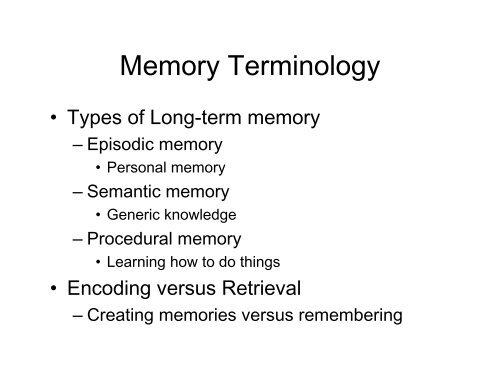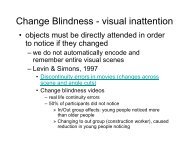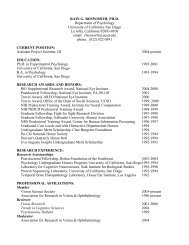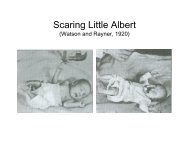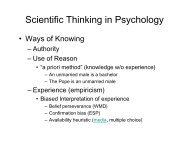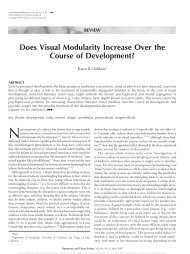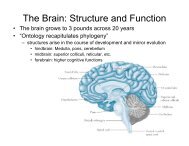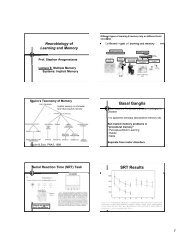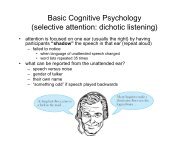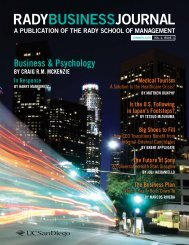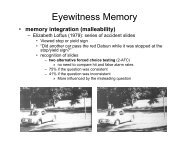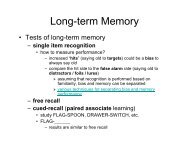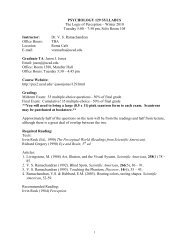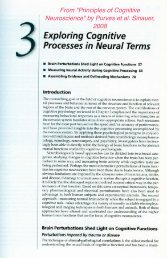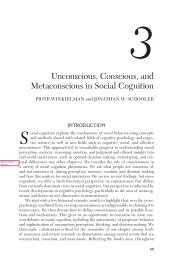Long-term Memory
Long-term Memory
Long-term Memory
Create successful ePaper yourself
Turn your PDF publications into a flip-book with our unique Google optimized e-Paper software.
<strong>Memory</strong> Terminology<br />
• Types of <strong>Long</strong>-<strong>term</strong> memory<br />
– Episodic memory<br />
• Personal memory<br />
– Semantic memory<br />
• Generic knowledge<br />
– Procedural memory<br />
• Learning how to do things<br />
• Encoding versus Retrieval<br />
– Creating memories versus remembering
• Modal view of memory (qualitative differences<br />
between STM and LTM)<br />
– Capacity<br />
• STM around 7 chunks, LTM nearly unlimited<br />
– Duration<br />
• STM around 30 seconds, LTM can last a lifetime<br />
– Bahrick (1984) memory for Spanish class declined during first 6<br />
years, but there was no further forgetting even out to 35 years<br />
– Coding<br />
• STM is acoustic<br />
– confuse “b” and “g”<br />
• LTM is semantic<br />
– Baddeley (1966a) – 20 minutes after studying a list<br />
» poor recall for semantically similar lists (HUGE, BIG, SIZE,<br />
etc.)<br />
» normal recall from acoustically similar lists (MAD, MAP,<br />
MAN, etc.)
A Unitary Account of <strong>Memory</strong><br />
• levels of processing: the only difference between STM<br />
and LTM is whether encoding is “shallow” or “deep”<br />
– memory is a continuum, rather than different modes<br />
– deep processing is more semantic and self-referential and<br />
results in stronger, longer lasting memories<br />
• Semantic memories are more distinctive (unique)<br />
• Semantic memories involve elaboration (interconnected)<br />
– shallow processing is concerned with physical characteristics<br />
and results in weaker, temporary memories<br />
– Craik and Tulving (1975) had participants study words with the<br />
following tasks (listed from worst to best memory)<br />
• Is it in upper case?<br />
• Does it rhyme with ?<br />
• Does it fit in the sentence ?
<strong>Long</strong>-<strong>term</strong> <strong>Memory</strong><br />
• Tests of long-<strong>term</strong> memory<br />
– recognition<br />
• how to measure performance?<br />
– increased “hits” (saying old to targets) could be a bias to<br />
always say old<br />
– compare the hit rate to the false alarm rate (saying old to<br />
distractors / foils / lures)<br />
» If familiarity is compared to a criterion, bias and memory<br />
can be separated<br />
– free recall<br />
– cued-recall (paired associate learning)<br />
• study FLAG-SPOON, DRAWER-SWITCH, etc.<br />
• FLAG-______<br />
– results are similar to free recall
Results<br />
• Forgetting Curves<br />
– Ebbinghaus’s (1885) nonsense syllable experiment<br />
• over the course of days, he kept on relearning lists of nonsense<br />
syllables (e.g., RUR, HAL, BEIS, etc.)<br />
• forgetting was measured as percent savings (a comparison of<br />
immediate testing versus testing after a delay)<br />
• information is rapidly forgotten at first (non-linear)
Results cont.<br />
• recall is better when context is kept the same<br />
– encoding specificity<br />
• Thomson and Tulving (1970) – word context<br />
– e.g., studied ‘ground-COLD’<br />
» better recall with ‘ground-?’ than ‘hot-?’<br />
• Golden and Baddeley (1975) – environmental context<br />
– words learned on land or underwater<br />
– words tested on land or underwater<br />
memory<br />
performance<br />
study<br />
on land<br />
study<br />
underwater<br />
test<br />
underwater<br />
test<br />
on land
– encoding specificity cont.<br />
• Marian and Fausey (2006) – language context<br />
• Bransford et al. (1979) – processing context<br />
– Rhyme encoding produces best performance if rhyming<br />
is also used at test (deep processing isn’t always best)
– encoding specificity cont.<br />
• state-dependent learning – a match between<br />
pharmacological states improves memory (Eich, 1980)<br />
memory<br />
performance<br />
study<br />
drunk<br />
study<br />
sober<br />
test<br />
sober<br />
test<br />
drunk<br />
• mood congruence – a match between moods states<br />
affects memory (Murray et al., 1999)<br />
– Depressed people recalled less than nondepressed people<br />
– Nondepressed people recalled many more positive words<br />
than negative words<br />
– Depressed people recalled slightly more negative words<br />
than positive words
Results cont.<br />
• memory is worse when semantically similar<br />
items are studied<br />
– A,B,C, vs. A,A’,A’’ (false memory effect)<br />
• memory for any particular item is worse when<br />
more items are studied<br />
– A,B,C vs. A,B,C,D,E,F (length effect)<br />
• memory is better when each item is studied for a<br />
longer period of time<br />
– A,B,C vs. A,A,A,B,B,B,C,C,C (strength effect)<br />
– however, distributed study is better than massed<br />
study<br />
• spacing effect<br />
– A,A,A,B,B,B,C,C,C vs. C,A,B,A,B,C,B,A,C<br />
– Encoding variability
edspread<br />
betrayal<br />
donate<br />
escapade<br />
holly<br />
iceberg<br />
missile<br />
numeral<br />
outcast<br />
painless<br />
plumber<br />
plural<br />
priority<br />
rancher<br />
reversal<br />
skeleton<br />
trigger<br />
trinket<br />
waffle
Amnesia
• Bilateral damage to the medial temporal lobes (including<br />
the hippocampus)<br />
– inability to make new memories<br />
• anterograde amnesia<br />
– some loss of old memories from just before the damage<br />
• retrograde amnesia<br />
– sources of damage<br />
• permanent: Surgery, stroke, hypoxia, head injury, encephalitis<br />
• progressive: Korsakoff’s syndrome, Alzheimer’s disease<br />
• temporary: electroconvulsive therapy (ECT), benzodiazepines<br />
• unilateral hippocampal damage<br />
– left = verbal memory<br />
– right = spatial memory<br />
• hippocampal versus parahippocampal damage<br />
– recall versus familiarity?<br />
brain<br />
damage<br />
PAST PRESENT<br />
retrograde<br />
anterograde
• Anterograde amnesia<br />
– Inability to form new long-<strong>term</strong> episodic<br />
memories<br />
• general knowledge and personal history are frozen<br />
– poor at recall, recognition, etc.<br />
– no new vocabulary (e.g. jacuzzi, granola, etc.)<br />
• intact STM / working memory<br />
• all modalities affected<br />
• Skill learning<br />
– Implicit learning, but no explicit memory (dissociation)<br />
» procedural versus declarative<br />
– motoric or perceptual (i.e., cannot learn chess)<br />
» rotary pursuit<br />
» mirror tracing<br />
» mirror image reading<br />
» new words (not meaning)<br />
» long-<strong>term</strong> priming (stem and fragment completion)
ed__<br />
bet__<br />
don__<br />
esc___<br />
hol___<br />
ice___<br />
miss___<br />
num___<br />
out___<br />
pain___<br />
pl_m__r<br />
p_ur_l<br />
pr_o_ity<br />
ra_c_er<br />
re_e_sal<br />
s_el_ton<br />
t_ig_er<br />
t_in_et<br />
w_f_le
• Retrograde amnesia<br />
– loss of old memories<br />
• some retrograde amnesia with hippocampal damage<br />
– the period just before the injury is forgotten (temporally graded)<br />
– memory consolidation (Squire)<br />
• Memories are dependent on the hippocampus for awhile<br />
– with time, the cortex can learn the memories<br />
– this process is called memory consolidation
Narrative and Autobiographical <strong>Memory</strong><br />
• Do laboratory studies apply to real life memories?<br />
– Bartlett (1932) thought narrative memory is often<br />
reconstructed based on schemas<br />
• Schema: general knowledge or expectation distilled from past<br />
experiences (i.e., the ‘gist’ of things)<br />
– e.g., the ‘eating lunch’ schema<br />
• constructivist view of LTM<br />
• serial reproduction: repeated recall the same story<br />
– Native American story, “War of the Ghosts”, became more distorted<br />
and westernized with each reproduction<br />
– Consistency bias<br />
• Memories are made to be consistent with current self-schema<br />
– Source monitoring errors<br />
• Attributing a memory from source A to source B<br />
– Reality monitoring errors<br />
• Thinking something happened that was just imagined or<br />
planed
– Autobiographical memory for ordinary events<br />
• Marjorie Linton (1975, 1982) spent six years recording the daily<br />
events in her life (2 per day) in a systematic fashion<br />
• each day short descriptions of important events<br />
– the date, how distinctive, how emotional, importance to life goals<br />
• tested herself at delays up to three years<br />
– order two events (which happened first)<br />
– provide exact dates of events<br />
• performance was good at all delays<br />
– real life memories are more durable than what Ebbinghaus found<br />
– she often used problem solving to arrive at the dates of events<br />
» constructivist view of memory<br />
• events that she could not recall where often similar to other events<br />
she could not recall<br />
– repeated similar events can start to form a schema
Flashbulb Memories<br />
(Brown & Kulik, 1977)<br />
• personal events at time of disaster<br />
– JFK assassination, Challenger explosion, start of gulf war, 9/11<br />
• physiological response<br />
– emotional response causes hormone release<br />
• better encoding<br />
• However, positive events better remembered than negative (see pp.<br />
137-140)<br />
– Students in NYC recalled more facts than students in California<br />
• stronger emotional responses = more details
• Weaver (1993) compared intentional memory to<br />
flashbulb memory<br />
– remember next meeting with roommate<br />
• Tested immediately, 3 months, 1 year<br />
– gulf war started at same time (direct comparison)<br />
• No accuracy differences<br />
• Higher confidence for flashbulb<br />
• Talarico & Rubin (2003) compared forgetting of flashbulb<br />
memory to ordinary event
Own Race Bias (ORB)<br />
• People are best at remembering and perceiving<br />
faces of their own race<br />
– Contact hypothesis (Walker & Hewstone, 2006)
ORB and Cue Utilization<br />
• Different races make different eye cosmetic<br />
alterations<br />
– Caucasians: 85% of people who wear soft contact<br />
lenses wear colored lenses (Contact Lens Council, 2000)<br />
– Asians: 39% of plastic surgeries are blepharoplasties, or<br />
double eyelid surgeries (AAFPRS, 2007)
proportion of<br />
descriptions<br />
0.6<br />
0.5<br />
0.4<br />
0.3<br />
0.2<br />
0.1<br />
0<br />
Descriptors Used<br />
Iris Color Eyelid Crease<br />
Asian test face Caucasian test face<br />
Asian Caucasian<br />
Participant race<br />
60<br />
50<br />
40<br />
30<br />
20<br />
10<br />
0<br />
Asian Caucasian<br />
Participant race
Eyewitness <strong>Memory</strong><br />
• memory integration (malleability)<br />
– Elizabeth Loftus (1978): series of accident slides<br />
• Viewed stop or yield sign<br />
• “Did another car pass the red Datsun while it was stopped at the<br />
stop/yield sign?”<br />
• recognition of slides<br />
– two alternative forced choice testing (2-AFC)<br />
» no need to compare hit and false alarm rates<br />
» Post-event misinformation effect (retroactive interference)
Eyewitness Lineups<br />
• what’s the best way to conduct a lineup?<br />
– maximize identification of guilty suspects (hits)<br />
– minimize identification of innocent suspects (false alarms)<br />
• selecting distractors in a lineup (known-innocents)<br />
– the use of mock eyewitnesses<br />
– match-to-description, or also resemble-suspect?<br />
• either way, innocent suspect is protected<br />
• if distractors resemble-suspect, identification of guilty suspect is lower<br />
• demand characteristics<br />
– subtle cues<br />
– exert pressure to select (relative judgment)<br />
– double-blind eliminates these concerns<br />
• Not adopted by law enforcement<br />
• relative judgments versus absolute identification<br />
– sequential lineups emphasize absolute identification<br />
• reduces identification of innocent suspects<br />
• however, also reduces identification of guilty suspect<br />
• w/o double-blind, can increase demand characteristics
False <strong>Memory</strong> Effect<br />
• Deese (1959) and Roediger<br />
and McDermott (1995) (DRM)<br />
– False recall of critical lure*<br />
– False alarm rate for critical lures*<br />
as high as hit rate<br />
• Explained by summed similarity to<br />
all memories (Shiffrin, Huber, &<br />
Marinelli, 1995)<br />
Test List<br />
Patient<br />
*Doctor<br />
Rest<br />
*Sleep<br />
Nurse<br />
Sick<br />
Medicine<br />
Health<br />
Hospital<br />
Dentist<br />
Physician<br />
cure<br />
Patient<br />
Office<br />
Study Lists<br />
Surgeon<br />
Bed<br />
Rest<br />
Awake<br />
Tired<br />
Dream<br />
Snooze<br />
Blanket<br />
Doze<br />
Snore<br />
Nap<br />
Yawn
Recovered Memories<br />
• Therapy and police interrogation can result in<br />
recovered memories. Are these real?<br />
– Practices that might cause false memories<br />
• Hypnosis<br />
• Imagination exercises<br />
• Leading questions<br />
– Memories can be implanted<br />
• Loftus and Pickrell (1995): 3 true events and one false<br />
“lost-in-the-mall”<br />
– Booklets describing stories (4-6 years) were created by<br />
interviewing relatives<br />
– Participants asked to fill in additional details<br />
– 68% of true stories and 29% of false stories ‘remembered’
• Hyman, Husband, and Billings (1995)<br />
– embarassing stories (e.g., spilling punch bowl at a wedding)<br />
» 80-90% of true events<br />
» no false events recalled in first interview<br />
» 20% in a second interview<br />
» some participants elaborated upon their false memories<br />
(added details never presented)


